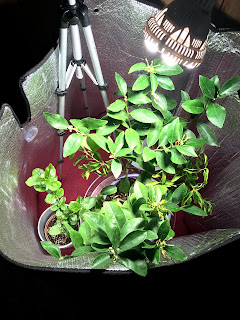Get a Light!
Within my experience, “a bright room” seldom bright enough for sun-loving plants. (Quick note: almost all flowering plants are sun-loving.) I have managed to keep one citrus plant happy near a southern facing office window, where the light coming through is blindly bright that makes human eyes uncomfortable.
With all that saying, if you love to have blooms indoor, you
likely NEED a grow light, perhaps a bunch of grow lights, to make them perform.
How many grow lights you need and what kind of grow light serve you best all
depend on your plant collection. Here are a few important questions to ask:
1.
Divide your plants into low light, medium light,
and high light requirement groups. How many do you have under each group?
While low light plants (typically foliage plants) can tolerate dim indoor environment just fine, starting from medium light group, you face the choice of either getting a bright window or purchasing a light. High light plants will need supplemental light, in addition to being placed right beside a bright window.
2.
Do you group plants in a corner or scatter them
all over your place?
I group my plants in a corner so that a minimum number of lights can benefit all. If you scatter plants for decoration purposes, you will need more lights for various spots.
3.
Do you have at least a bright window to keep
plants near to?
Under all circumstances, bright windows are favorable. You can get away with no supplemental light or a less powerful light in general.
Which light do I choose?
I chose Sansi as I’ve always aware that I need a powerful light that does not cost too much. All of my plants are kept in a dark basement, away from my toddler, the pot-knocker, and the dirt-player, among which three are light-needy citrus trees. For the price (around CAD 50 on amazon), I have yet to find a trustworthy manufacturer who claims higher PAR.
You can google PAR for its scientific definition. In plain language, PAR is the level of light that plants perceive which can be quite distinct from human perception. Simply put, a 3000 lm regular LED light won’t be able to provide the same amount of light for plant absorption compared to a 3000 lm grow light with a high PAR rating. A good LED grow light provides a specialized mixture of lights with certain wavelengths. This is why grow lights are typically pricier, as the product development and manufacturing cost is higher in serving a smaller market. If you were a plant, you will enjoy bathing under a combination of light that is mainly made up of blue and red, with a touch of green and better yet, some UV rays.
Just as you know, commercial growers will even purchase customized-spectrum
light for some specialized crops. GE is turning towards this professional trend
in releasing its grow light lines in two different receipts for the vast
market: Balanced and Bloom. As a home grower, I am contented with my Sansi
bulbs offering a balanced spectre.
Depending on the size of your plant collection, grow light
with high wattage might be necessary. As most of our fellow gardener friends
tend to have a growing collection over the years, ultimately you may have to
look into LED grow light panels. Panels are not cheap – starting from $100 to
$500 range – but can still save you money if you have a large collection that
otherwise cost a fortune to purchase smaller individual lights.
From my experience, a 36w grow light is at the higher output
range for light bulbs (We are excluding panels here. They usually comes with
hundreds of watts). It is too bright for use in living space (unless you have a
curtain to separate the growing space), but just right to light a table of
succulents from one foot’s distance. If you want something that goes along with
your living space or simply want to supplement by a window, looking for bulbs
within 9-15 watts range.
I hope this post would be useful for those wondering about
the truths and myths in choosing indoor grow lights. I am also aware that there
are more products available in the market every year, so keep me posted if you
have a better hunt.



Comments
Post a Comment